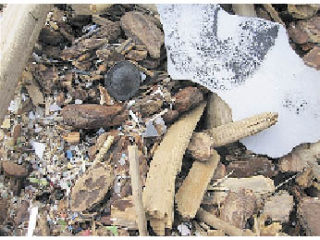WSU Beach Watchers San Juan County, along with other interested volunteers, are supporting marine plastic pollution research and education under the guidance of the Port Townsend Marine Science Center.
Thirty-five beaches in 12 counties around Puget Sound and the Northwest Straits (the Salish Sea) are surveyed twice a year for marine micro-plastics. Beaches on Orcas, Lopez and San Juan Islands are included in the project.
But do we have a problem with plastics? Quantities of plastic trash are frequently visible on our beaches, but micro-plastics, meaning pieces five millimeters or smaller, are not as obvious to the naked eye (for perspective: a millimeter, more or less, is the thickness of your fingernail.)
The plastics do not bio-degrade, but simply get smaller and smaller until they are no longer visible. The overall effects of micro-plastics, pervasive, food mimicking, enduring and perhaps toxic, on the marine food web and beyond are undetermined, but under study. Data collected by volunteers contribute to this research. The tiny plastics fall into several categories, including: foam, fragments and “nurdle.”
Nurdles are lentil-sized pre-production pellets that unfortunately resemble fish eggs and are used for thousands of plastic products like milk jugs.
In last April’s survey, samples on Orcas were taken from Crescent Beach and Eastsound Waterfront Park.
The number of plastic bits between one and five millimeters counted in 45 liters of beach material was 300 for Crescent Beach. The number for Fishing Bay was 10,177. The results are not yet in for the recent fall sampling.
Many resources are available online about plastic pollution. An international online campaign, REFUSE, organized by the Plastic Pollution Coalition, challenges individuals and businesses to refuse disposable plastics. It also challenges industry, policymakers, and nations to stem the flow of plastics into our environment, where they do so much damage, particularly to the ocean, and to human health as well. To learn more about this event, the challenge, and the nature of the problem, go online and Google “tedx plastics.”
If you prefer to receive your information with inspiration, try watching Beth Terry on Youtube or read her blog “FakePlasticFish”. In 2009, inspired by an albatross killed by the kind of plastics most of us use daily, Terry reduced her plastic consumption to under 4 pounds, dramatically less than the national average of 88 pounds.
For more information about the Marine Micro-Plastic Monitoring program in the Salish Sea, go to the Port Townsend Marine Science Center website, ptmsc.org, and click on “the plastics project” under “science”. Future volunteer samplers on Orcas are most welcome!
To learn more about marine micro-plastics, nurdles, all things marine plastics and the Pacific Garbage Patch (aka “the Pacific Gyre”) try these sites: mindfully.org (type in “trashed” in the search box); Algalita Marine Research Foundation – algalita.org; International Pellet Watch – tuat.ac.jp.
For further information, to volunteer, if you would like a micro-plastics presentation for your group or organization, or a tour of the micro-plastic/ nurdle pockets of Fishing Bay, please contact Marcia Spees: speesart@centurylink.net.
Finally, if you would like to turn your love of the marine environment into service for you local area, please consider joining the 2011 class of WSU Beach Watchers, starting in March. Contact Coordinator Shann Weston at 370-7666, sweston@wsu.edu or check out our website at www.beachwatchers.wsu.edu.




